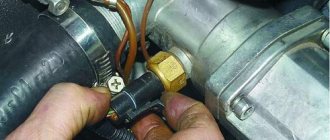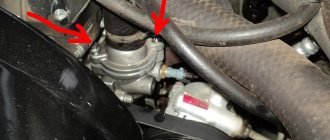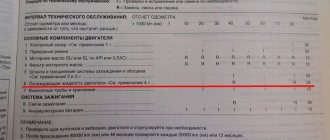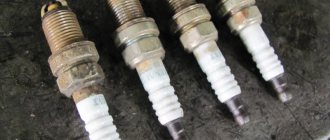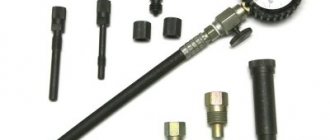First, it’s worth understanding why temperature meters are needed in a car. It is completely clear what internal and external air temperature meters do. They carry out their measurements, transmit a signal to the car’s ECU, and thanks to their work, the car either carries out climate control, or regulates the operation of the car’s mechanisms, or simply displays the obtained measurements on the dashboard (however, this is often done bypassing the ECU altogether).
Why, for example, do you need a coolant temperature sensor (DTOZH)? His work, although it seems just as obvious, is actually deeper in nature. So, before antifreeze enters the engine, it passes through a meter, which records its temperature and sends it to the main computer. These measurements serve as analytical data for the processor, giving it an understanding of the efficiency of the heatsink. After all, the coolant travels a long way, through the engine to the radiator, and then, wobbling through its tubes, returns to the engine, where it is re-measured.
The radiator is designed in such a way that air flows counter to the car cool the antifreeze without unnecessary costs on the part of the car. However, in hot weather or standing in a traffic jam, this may not be enough, and then the computer decides to turn on additional cooling in the form of fans located inside.
At the same time, the Lada Granta DTOZH, with its measurements, helps the computer determine the need for additional fuel injection. Although more often devices that measure incoming air or outgoing air (exhaust) are responsible for this.
As a result, the main positive criteria for the work of the DTOZh include:
- reduction in fuel consumption;
- reducing wear on machine mechanisms;
- improving vehicle performance and avoiding overheating.
This can also include bonuses such as notification to the driver or analysis of the operation of one or another form of coolant. But this already depends on the ability of the drivers themselves to recognize such signals.
The sensor is installed in the engine cooling system. The sensitive element of the sensor is a thermistor, the electrical resistance of which varies inversely with temperature.
Removing the coolant sensor Lada Granta
The Lada Granta coolant temperature sensor is a thermistor (a resistor whose resistance changes depending on the temperature). The sensor is screwed into the thermostat housing and connected to the controller input, connected to an internal voltage source of 5 V through a 2 kOhm resistor. At low temperatures, the resistance of the sensor is high, and at high temperatures it is low (Table 1). The controller calculates the coolant temperature from the voltage drop on the sensor. On a cold engine the voltage drop is high, and on a warm engine it is low. Coolant temperature affects most of the characteristics controlled by the controller.
To remove the sensor you will need: a 19mm wrench and a multimeter.
If you have a 21126 engine, then you can see the algorithm for removing the sensor in the article “Replacing the coolant temperature indicator sensor in Lada Priora”
Design of the engine cooling system on Grant
The cooling system on Grant is liquid, closed type. The design involves forced distribution of coolant to all engine elements that need it. The fluid flow diverges evenly.
Despite some differences in Granta engines of various configurations, the cooling system works the same on all.
Let's look at the main elements of ODS on Grant:
Liquid pump.
The regular and uniform supply of antifreeze or antifreeze (coolant) to the heated engine elements depends on it.
The pump is located on the front surface of the cylinder block. As soon as the gas distribution mechanism is activated, under the action of the toothed belt, the water pump begins pumping fluid. The pump does not require lubrication, as it is equipped with closed bearings.
If it breaks down, the liquid pump cannot be repaired. For the continued functioning of all parts of the cooling system, the old pump must be replaced with a new one.
Thermostat.
Equipped with a solid heat-sensitive filling, which helps maintain the required coolant temperature.
When operating a vehicle, this system significantly reduces the time spent warming up the engine.
The thermostat design implies the presence of a main and additional bypass valve. If the coolant temperature does not exceed 85 degrees, the thermostat is closed, preventing fluid from moving through the radiator. Due to this, the time for warming up the engine is reduced. The thermostat directs fluid to the radiator at temperatures above 85 degrees.
Radiator and expansion tank
The radiator device is equipped with plastic tanks and hoses leading to the engine water jacket and expansion tank.
The radiator on Grant is manufactured by a French manufacturer. The design and operating principle of the device is similar to the performance of radiators installed on Renault Logan.
The expansion tank has the function of compensating and smoothing the amount of liquid evaporating due to temperature changes.
Electric fan.
Made of plastic and has the function of cooling the radiator with air flow.
Usually, the radiator is cooled by a natural, oncoming flow of air when the car is moving, but sometimes it happens that this is not enough.
Problems caused by malfunctions in the Lada Granta engine cooling system
In a Lada Granta car, the cooling system in the operating scheme is quite typical. Accordingly, the problems associated with it are often typical.
Let's look at some known problems associated with the Lada Granta ODS, as well as their possible solutions:
The engine gets very hot.
This problem can be caused by several reasons:
— there is not enough coolant in the system (needs to be added);
— the thermostat does not open (you need to buy and install a new thermostat);
— the pump does not function (the liquid pump needs to be replaced);
— the valves in the expansion tank are faulty (check, replace).
The heater in the car blows a cold stream of air.
This problem is often accompanied by engine overheating. Most likely it's a bad cylinder head gasket. This leads to coolant leakage and the formation of vapor locks in the cooling system.
To resolve the problem, it is necessary to replace the cylinder head gasket.
The engine takes a very long time to warm up.
The problem is most likely a faulty thermostat. When broken, it hangs in a closed or open state (in this case, open).
A new thermostat needs to be installed.
Rapid decrease in coolant level in the tank.
The problem can be caused by several reasons:
— leaky connection between the radiator and expansion tank (check for integrity and tightness of the connection);
— hoses are damaged (check integrity, replace);
— leakage through the cylinder head gasket (check, replace).
Warming up the engine correctly (tips)
Since environmental legislation in our country is not very well developed, it makes sense to warm up the car’s engine. Just warming up the car will not change anything, while the harm from the “05” Kamaz is much greater!
It is recommended to wait until the engine temperature rises to 90 degrees Celsius. This can be a problem due to the design of the car thermostat and the cooling system as a whole. AvtoVAZ even has instructions to dealers that underheating above 80 degrees is not a breakdown. By the way, most cars do not have a temperature indicator (see the material “How to check the temperature of the Lada Granta engine”).
90 degrees is already a completely comfortable indicator, even for working in light overload mode. But until this moment, try not to raise the engine speed above the mark of two and a half thousand.
engine
So, it all starts with the fact that we turn the key in the ignition. The tachometer readings rise above the 1 thousand rpm mark, after which they immediately fall below this figure. Here the automation comes into play, automatically adjusting the speed to a level of 950.
The waiting time can be spent usefully. Clear snow from your car while the engine is warming up.
Now we just wait. During this time, you can just brush off the snow from the car, and also turn on the heater to defrost the windshield and warm up the interior. As soon as you see the temperature increase to 40 degrees or more, you can start moving. Of course, this is only relevant for careful driving with a minimum number of revolutions.
Of course, it will take 20-30 minutes to fully warm up, which is about half a liter of gasoline. This is not much if you plan to travel far, but when traveling a distance of a couple of kilometers, this increase in fuel consumption can be significant.
And, of course, remember about the mandatory warm-up when the car is very heavily loaded with luggage or people. There is already a question of preserving the life of the motor, which suffers from insufficient power at low ambient temperatures.
Operating temperature of the 8-valve Lada Granta engine
The operating temperature of the engine in a Lada Granta car should be 90 degrees, but most owners complain that the temperature does not rise above 80 degrees. Even despite the above-zero temperature outside.
Apparently AvtoVAZ decided to further protect itself by installing a thermostat that opens already at 85°. The most interesting thing is that AvtoVAZ defines the tolerances for the opening temperature of the thermostat as: (85±8.3) ºС, i.e. from 77 to 93 ºС. This is a scatter, isn't it?
The operating temperature of the engine must be at least 90ºС.
To learn how to find out the engine temperature when your car is not equipped with a temperature indicator on the instrument panel, read the material: how to check the engine temperature.
Disadvantages of low engine operating temperature
An engine that does not reach its operating temperature operates in the wrong modes.
- The most basic problem is increased fuel consumption (read how to reduce fuel consumption on a Lada Granta here).
- There is also a risk of breakage.
- Well, the car interior will not warm up so well.
Remedies
Only replacing the thermostat with a model with an opening temperature of at least 92 degrees will help. Grantmakers purchase a WAHLER 3091.92D thermostat, take the insides out of it, and insert it into the old thermostat.
In order not to disassemble the original thermostat ahead of time, you can purchase a thermostat for the Lada Granta, and put the insides from a non-original replacement into it.
This is a native Luzar thermostat
Information letter AvtoVAZ (excerpt)
Excerpt from the “Information letter to AvtoVAZ dealers.”
4.3 Owners of cars of the Lada Granta (2190) and Kalina FL (2192, 2194) families state a fact: the average coolant temperature on their current cars is 7–10 degrees lower than on the previous Priora, Samara and Kalina models. Due to subjective “unusuality”, this fact has been elevated by consumers and service station personnel to the rank of a discrepancy (defect) called “underheating” of the engine.
4.4 Maintaining the coolant temperature on cars of the Lada Granta (2190) and Kalina FL (2192, 2194) families in the temperature range below the “usual” ones on previous car models Priora, Samara and Kalina does not lead to increased fuel consumption, increased wear of engine parts and no other negative consequences. Accordingly, in the absence of negative consequences and the absence of a coolant temperature standard, “underheating” of the engine according to clause 4.3 is not a non-compliance (defect).
How to remove air from the Granta cooling system
- Allow the engine to cool.
- Unscrew the expansion tank cap.
- Start the engine and let it run for 3-5 minutes.
- Close the tank lid.
- To better fill the system without air locks, periodically squeeze the radiator hoses by hand.
By the way, do you know what kind of antifreeze is poured into the Granta?
Tools:
- Ratchet wrench
- Extension
- 8 mm head
- 10 mm head
- 13 mm head
- Funnel
Parts and consumables:
- Coolant 8 l
- Technical capacity
- Rags
Notes:
The fluid in the engine cooling system should be replaced every 75 thousand km of the vehicle or after five years, whichever comes first, in accordance with the maintenance schedule. It is more convenient to replace the coolant when the car is installed on an inspection ditch or overpass. If the engine is hot, you need to let it cool and then relieve excess pressure in the cooling system by unscrewing the expansion tank cap.
Coolant drain
1. Remove the middle engine compartment mudguard as described in this article.
2. Place a wide container with a volume of at least 6 liters under the drain hole made in the lower part of the right radiator tank.
3. Unscrew the plastic drain plug of the radiator tank and drain the coolant into a container.
Note:
To reduce the intensity of liquid drainage at the initial moment, screw the expansion tank cap tightly.
4. To increase the intensity of liquid drainage, unscrew the cap of the expansion tank.
5. To drain the coolant from the engine cooling jacket, place a container under the drain hole located on the front side of the cylinder block below the ignition coil.
6. Using a 13mm socket, unscrew the drain plug of the cylinder block and drain the liquid into a container.
Filling the cooling system
1. Tighten the drain plugs of the radiator and cylinder block.
Note:
The cylinder block drain plug has a tapered thread, so screw and tighten it until the rotation resistance increases sharply.
2. Fill the cooling system with liquid through the expansion tank (at this stage, about 6-7 liters of liquid enter the system).
3. Start the engine. Move the air temperature regulator handle in the heating and ventilation system control unit to the red sector of the scale.
4. With the engine running, vigorously compress all the cooling system hoses several times in turn.
Note:
Such actions will help the fluid fill the system and displace air from it.
5. As the coolant level in the expansion tank drops, bring it to normal and tighten the tank cap.
Note:
When the engine warms up, the outlet (lower) radiator hose should be cold for some time, and then quickly heat up, which will indicate the beginning of fluid circulation in a large circle.
6. Check the operation of the heater inside the car. After waiting for the cooling fan to turn on, stop the engine.
7. After the engine has cooled, check the coolant level in the expansion tank again and add if necessary.
8. Remove any coolant leaks with a rag.
Motor oil is a key component in any car. Without it, he will not be able to fully work. There is a wide range of lubricants on the market. They differ in brand, composition, viscosity and other characteristics that provide them with special chemical properties. When choosing consumables for LADA Granta, you must take into account the manufacturer's technical instructions. The functionality of the power unit depends on how correctly the fluid is selected.
The role of lubrication for parts is great. It forms a special film inside the unit that protects it in adverse operating conditions. Oil helps reduce friction during operation. As a result, the service life of the components is increased.
The frequency of the procedure is provided by the manufacturer and is indicated in the relevant documentation. He recommends changing the engine fluid for the first time after two thousand kilometers. Subsequent replacement is carried out after 15 thousand km. The engine block will hold 3.5 liters of oil.
The lubricant consumption rate is 1 liter per thousand kilometers. In reality this value is not respected. Oil consumption is slightly lower and depends on the technical condition of the machine, its operating conditions, viscosity and quality of the fluid. Fast driving and frequent acceleration lead to increased oil consumption.
Filling volumes and oil names for different power units of the Lada Granta are shown in the table.
Heating system control
To adjust the fan speed mode, the regulator has a gradation scale. The car owner independently selects the optimal fan rotation mode.
Heating system regulator in the cabin
Failure of the regulator blocks the operation of the entire vehicle interior heating system.
Interior ventilation and heating system of Lada Granta: checking, adjustment
The type of interior ventilation and heating system is supply and exhaust. The operating temperature of the interior heating fluid is in the range from 90 to 94°.
Warm (hot) air is supplied to the cabin by an electric fan. The feed speed is adjusted by a special regulator, which accelerates (reduces) the rotation speed of the impeller.
The electric motor has four positions:
- first;
- second;
- third speed;
- position: off
Stove motor
Air intake follows from the outside through air intakes under the frill in the engine compartment. A filter is pre-installed to clean the flow. Filling: synthetic material.




